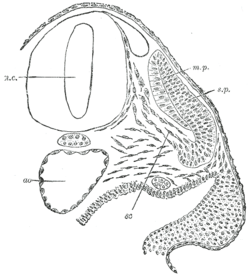Myotome: Difference between revisions
Appearance
Content deleted Content added
Removal of duplicated line |
No edit summary |
||
| Line 26: | Line 26: | ||
The term "myotome" is also used to describe the muscles served by a single nerve.<ref>{{eMedicineDictionary|myotome}}</ref> It is the motor equivalent of a [[Dermatomic area|dermatome]]. |
The term "myotome" is also used to describe the muscles served by a single nerve.<ref>{{eMedicineDictionary|myotome}}</ref> It is the motor equivalent of a [[Dermatomic area|dermatome]]. |
||
==See also== |
|||
[[Dermatome]] |
|||
==References== |
==References== |
||
Revision as of 08:29, 1 June 2008
| Myotome | |
|---|---|
 Scheme showing the manner in which each vertebral centrum is developed from portions of two adjacent segments. (Myotome labeled in upper right.) | |
 Transverse section of a human embryo of the third week to show the differentiation of the primitive segment. ao. Aorta. m.p. Muscle-plate. n.c. Neural canal. sc. Sclerotome. s.p. cutis-plate. ("Muscle-plate" is an older term for "myotome.") | |
| Details | |
| Carnegie stage | 13/14 |
| Precursor | somite |
| Gives rise to | muscle |
| Anatomical terminology | |
In vertebrate embryonic development, a myotome is a group of tissues formed from somites that develop into the body wall muscle.
Each myotome divides into a dorsal epaxial part and a ventral hypaxial part.
The epaxial muscle mass loses its segmental character to form the extensor muscles of the neck and trunk.
The myoblasts from the hypaxial division form the muscles of the thoracic and anterior abdominal walls.
The term "myotome" is also used to describe the muscles served by a single nerve.[1] It is the motor equivalent of a dermatome.
